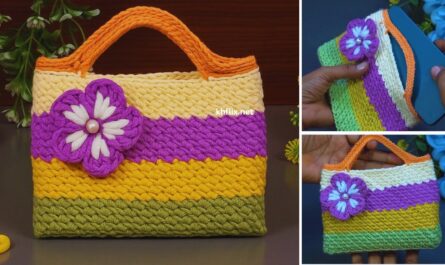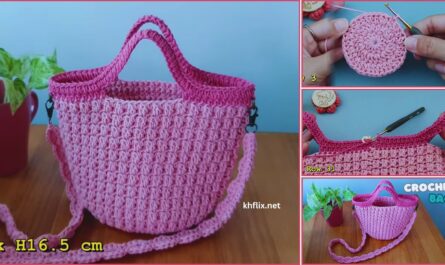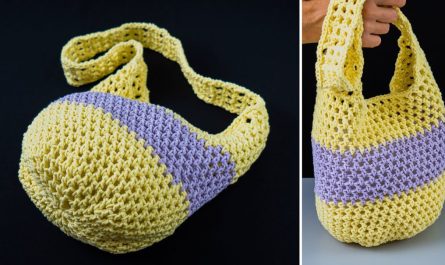You’re looking for a detailed tutorial on how to crochet a tote bag with a beautiful flower design! This is a fantastic project that lets you create a practical, stylish, and unique accessory. Instead of just a flat appliqué, we’ll integrate a three-dimensional flower directly into the bag’s construction, making it a real showstopper.
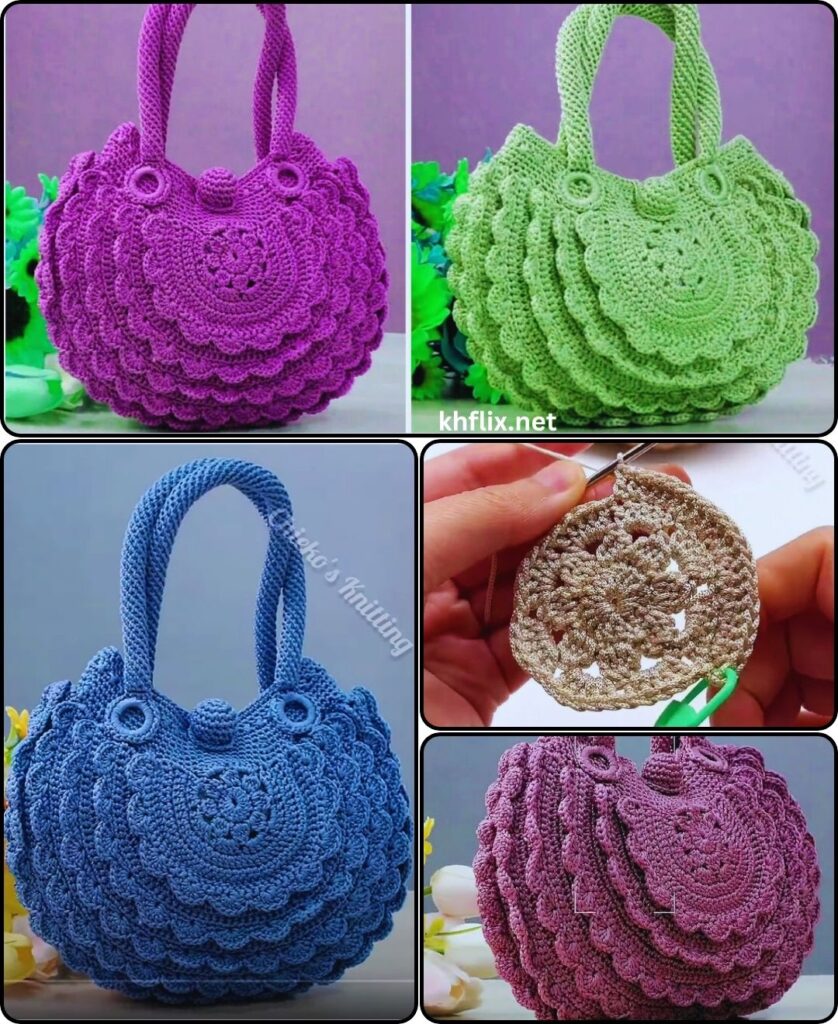
How to Crochet a Flower Tote Bag
This pattern will guide you step-by-step through creating a sturdy and charming tote bag featuring a prominent, multi-layered flower.
Skill Level: Intermediate to Advanced
To follow this tutorial, you should be comfortable with:
- Basic crochet stitches (chain, slip stitch, single crochet, half double crochet, double crochet, treble crochet).
- Working in joined rounds.
- Creating a flat oval base.
- Working straight sides for a bag.
- Working into specific loops (front loop only/back loop only) to create texture and layers for the flower.
- Understanding stitch placement for crocheting petals.
Finished Tote Bag Dimensions (Approximate):
- Width (flat): 12 inches (30.5 cm)
- Height (without handles): 14 inches (35.5 cm)
- Flower Diameter (on bag): 7-8 inches (18-20 cm)
Materials You’ll Need:
- Yarn:
- Worsted Weight (Medium #4) Cotton or Cotton Blend Yarn: This type of yarn is highly recommended for tote bags due to its durability, sturdiness, and washability.
- Total Yarn: Approximately 500-700 yards (450-640 meters).
- Colors: You’ll need four different colors for this project:
- Color A (Main Bag Color): Approx. 350-450 yards. This will be the primary color for your bag and the background for the flower.
- Color B (Flower Center/Accent 1): Approx. 50-70 yards.
- Color C (Inner Petals/Accent 2): Approx. 50-70 yards.
- Color D (Outer Petals/Accent 3): Approx. 50-70 yards.
- Crochet Hook:
- Size H/5.0mm: Or the hook size that helps you achieve a firm, dense fabric that won’t stretch too much when the bag is filled. A slightly tighter gauge is generally better for bags.
- Yarn Needle (Tapestry Needle): Essential for seamlessly weaving in all your loose ends.
- Scissors
- Stitch Markers (Recommended): Helpful for marking the beginning of rounds, corners of the base, and handle placement.
Gauge (Crucial for Consistent Size!):
Maintaining a consistent gauge is vital for your tote bag to achieve the intended size and shape, ensuring it’s sturdy and well-proportioned.
- For the main body (single crochet stitches): 15 single crochet stitches and 16 rows = 4 inches (10 cm).
- Adjust your hook size if necessary to meet this gauge.
Abbreviations Used:
- ch: chain
- sl st: slip stitch
- sc: single crochet
- hdc: half double crochet
- dc: double crochet
- tr: treble crochet (or triple crochet)
- st(s): stitch(es)
- inc: increase (work 2 stitches into the same stitch)
- BLO: back loop only
- FLO: front loop only
- FO: fasten off
- ( ): repeat instructions within parentheses a specified number of times.
- [ ]: indicates the total number of stitches at the end of a round.
Understanding Flower Tote Bag Construction:
This tote bag will be built in several distinct parts:
- Flat Oval Base: This creates a sturdy foundation for the bag, ensuring it sits flat.
- Bag Body: The main sides of the tote, worked straight up from the base.
- Integrated Flower: A beautiful, multi-layered flower will be crocheted directly onto the bag’s side, typically on one side, making it a prominent design element.
- Top Edging: This reinforces the bag’s opening, giving it a neat, finished look.
- Handles: Sturdy crocheted handles will be integrated directly into the top of the bag.
Let’s Start Crocheting Your Flower Tote Bag!
Part 1: Base of the Tote (Color A)
We’ll begin by creating a sturdy, flat oval base for your bag.
- With Color A, chain 37.
- Round 1: Single crochet (sc) in the 2nd chain from your hook. Sc in the next 34 chains. Work 3 sc in the very last chain. (Now you’ll be working down the other side of your starting chain). Sc in the next 34 chains. Work 2 sc in the very last chain (this is the same chain as your first sc of the round). Slip stitch (sl st) to the first sc to join. [74 stitches]
- Tip: Place stitch markers in the middle stitch of the 3-sc group at each end of the oval. These will be your “corner” stitches where you’ll make increases in subsequent rounds to maintain the oval shape.
- Round 2: Chain 1 (does NOT count as a stitch). Sc in the same stitch as your join. Sc in the next 33 stitches. Work 3 sc in the marked stitch (your old corner). Sc in the next 34 stitches. Work 3 sc in the marked stitch (your other old corner). Sc in the last 2 stitches. Sl st to the first sc to join. [78 stitches]
- Remember to move your stitch markers to the middle stitch of each new 3-sc group.
- Round 3: Ch 1. Sc in the same stitch. Sc in the next 34 stitches. Work 3 sc in the marked stitch. Sc in the next 36 stitches. Work 3 sc in the marked stitch. Sc in the last 2 stitches. Sl st to the first sc to join. [82 stitches]
- Move stitch markers.
- Round 4: Ch 1. Sc in the same stitch. Sc in the next 35 stitches. Work 3 sc in the marked stitch. Sc in the next 38 stitches. Work 3 sc in the marked stitch. Sc in the last 2 stitches. Sl st to the first sc to join. [86 stitches]
- Move stitch markers.
- Round 5: Ch 1. Sc in the same stitch. Sc in the next 36 stitches. Work 3 sc in the marked stitch. Sc in the next 40 stitches. Work 3 sc in the marked stitch. Sc in the last 2 stitches. Sl st to the first sc to join. [90 stitches]
- Your base should now measure approximately 12 inches long and 4-5 inches wide.
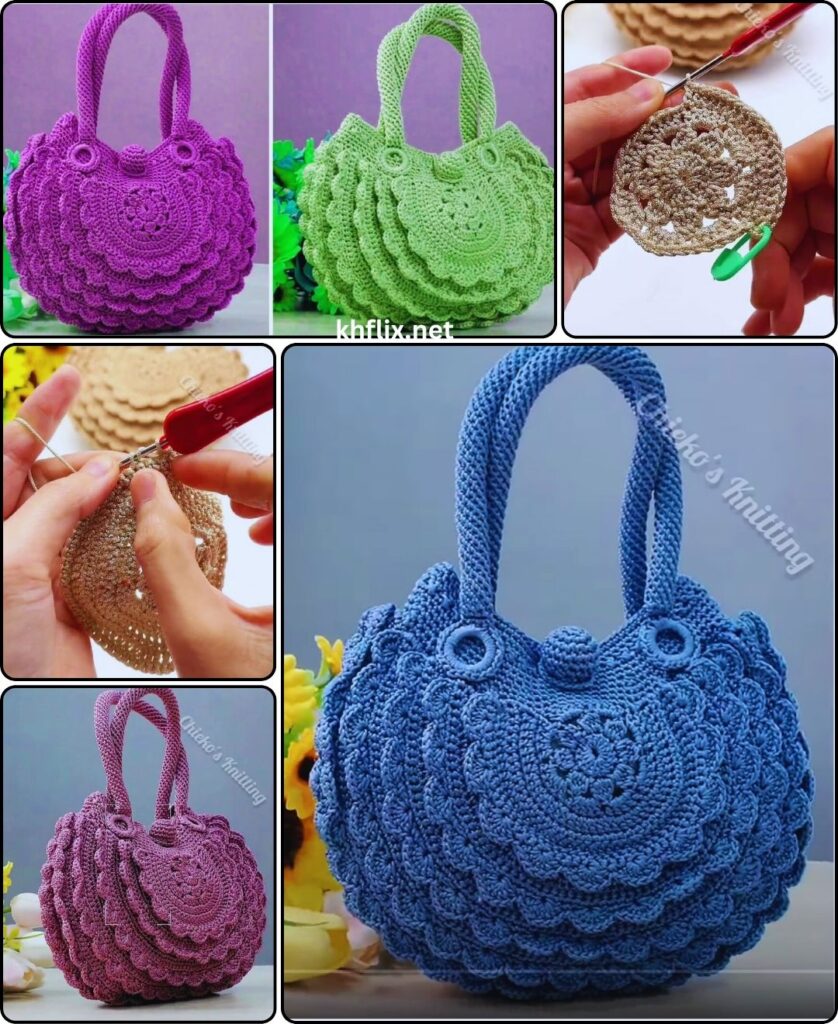
Part 2: Body of the Tote (Color A)
Now, we’ll work straight up to form the walls of the tote bag.
- Round 6: Ch 1 (does NOT count as a stitch). Sc in the back loop only (BLO) of the same stitch as your join. Sc in the BLO of each stitch around. Sl st to the first sc to join. [90 stitches]
- This BLO round creates a defined edge for the base and helps the sides stand up straight.
- Round 7 – 45 (or desired height): Ch 1. Sc in the same stitch as join. Sc in each stitch around (working through both loops). Sl st to the first sc to join. [90 stitches]
- Repeat this round until your bag reaches approximately 10 inches (25 cm) tall from the base (this will be about 40 rounds after Round 6). Do NOT cut Color A yet, as you’ll continue with it after the flower.
Part 3: Integrated Flower Design
This is the central, eye-catching feature of your tote! We’ll create a multi-layered flower directly on one side of the bag.
Placement: Lay your bag flat. The seam from your joined rounds (the vertical line where you join each round) should ideally be at the back of the bag. Mark the approximate center of the front side of your bag. The flower will be centered here.
Flower Core (Color B):
- With Color B, attach yarn with a sl st to a stitch on the bag’s body (Color A) that is positioned in the middle of your bag’s front side, roughly around Round 15-20 of the body (this will be the very center of your flower).
- Round 1 (Flower Center): Ch 2 (does NOT count as a stitch). Work 12 hdc into the same stitch where you joined (this forms a cluster that acts as the flower’s center). Sl st to the first hdc to join. [12 hdc]
- FO Color B, leaving a 6-inch tail for weaving.
Inner Petal Layer (Color C):
- With Color C, attach yarn with a sl st to any FLO (front loop only) of the stitches from Round 1 (Flower Center).
- Round 2 (Inner Petals): Ch 1 (does NOT count as a stitch).
- Work (sc in FLO of next st, hdc in FLO of next st, dc in FLO of next st, hdc in FLO of next st, sc in FLO of next st). (This sequence forms one 5-stitch petal).
- (Sl st in FLO of next st (this joins one petal to the next). Work (sc in FLO of next st, hdc in FLO of next st, dc in FLO of next st, hdc in FLO of next st, sc in FLO of next st)). Repeat from * to * 1 more time. You will have used 10 stitches from Round 1.
- Sl st in FLO of next st (the 11th stitch, leaving the 12th unused for this petal layer). Sl st to the first sc of the round (at the base of your first petal) to join. [3 petals]
- FO Color C, leaving a 6-inch tail. Gently push these petals forward to give them dimension.
Outer Petal Layer (Color D):
Now, we’ll create larger petals that sit behind the first layer. This requires working into the bag’s fabric (Color A) that is directly behind the flower core.
- With Color D, attach yarn with a sl st to a stitch on the bag’s surface (Color A) that aligns with the BLO (back loop only) of a stitch from the original Round 1 (Flower Center). You might need to gently push the inner petals forward to clearly see the optimal spot.
- Ch 1. Sc in the same stitch.
- You’ll need to create chain spaces on the bag’s surface that will form the base for your larger petals. Roughly divide the stitches around your flower center into 6 equal sections.
- (Chain 4, skip 3-4 stitches on the bag body, sc into the next stitch on the bag body). Repeat this 5-7 more times around the flower core, creating 6-8 chain-4 spaces. This requires you to estimate spacing on your bag to keep it even.
- Sl st to the first sc to join. [6-8 ch-4 spaces, depending on your spacing]
- Round 4 (Outer Petals Construction):
- Sl st into the first ch-4 space.
- Ch 1 (does NOT count as a stitch). Work (1 sc, 1 hdc, 2 dc, 1 tr, 2 dc, 1 hdc, 1 sc) into the same ch-4 space. This creates your first large outer petal.
- (Sl st into the next sc from Round 3 (between ch-4 spaces). Work (1 sc, 1 hdc, 2 dc, 1 tr, 2 dc, 1 hdc, 1 sc) into the next ch-4 space). Repeat from * to * around, forming all your larger outer petals.
- Sl st to the initial sl st (at the base of the first petal) to join.
- FO Color D, leaving a 6-inch tail.
- Refinement: Gently shape your flower petals with your fingers, pushing them slightly forward to enhance their three-dimensional look. You can dab a tiny bit of fabric glue (like Fabric-Tac) on the very back of the flower’s center (where it meets the bag) to secure it if it feels loose.
Part 4: Remaining Bag Body & Top Edging (Color A)
Now, we’ll finish the top part of the bag body above the flower and create a sturdy rim.
- Continue Body Rounds (Color A): Go back to Color A (the main bag color). Continue working Round 7 (Sc in each stitch around, sl st to join) for an additional 5-7 rounds, or until your bag reaches about 13-13.5 inches tall from the base. This will ensure the flower is positioned nicely, with enough space above it.
- Round (Top Edging 1): With Color A, Ch 1. Sc in the same stitch as join. Sc in each stitch around. Sl st to the first sc to join. [90 stitches]
- Round (Top Edging 2): Ch 1. Half double crochet (hdc) in the same stitch. Hdc in each stitch around. Sl st to the first hdc to join. [90 hdc]
- Round (Top Edging 3): Ch 1. Hdc in the same stitch. Hdc in each stitch around. Sl st to the first hdc to join. [90 hdc]
- DO NOT CUT Color A yet, as you’ll use it for the handles.

Part 5: Handles (Color A)
You will make two identical handles, crocheted directly onto the top edge of your bag.
- Handle Placement Preparation:
- Lay your bag flat and ensure the side seams are aligned.
- Using stitch markers, mark the precise placement for your handles. For a bag with 90 stitches around, a good handle placement could be:
- Starting from any side seam, count 15 stitches along the top edge, place a marker (this will be the start of your first handle attachment).
- From that marker, count 20 stitches, place another marker (this is the end of the first handle attachment section).
- Count the next 25 stitches, place a marker (this is the gap for the armhole).
- From that marker, count 20 stitches, place another marker (this is the start of the second handle attachment section).
- The remaining 10 stitches should meet the initial side seam (the second armhole gap).
- Round (Handle Base):
- With Color A, Ch 1. Sc in the same stitch as join and in the next 19 stitches (to the first marker). [20 sc]
- Chain 40 (this creates the length of your first handle strap).
- Skip the next 25 stitches along the bag’s top edge (this creates the opening for your arm/hand).
- Sc in the next 20 stitches (to the second marker). [20 sc]
- Chain 40 (for your second handle strap).
- Skip the last 25 stitches along the bag’s top edge.
- Sl st to the first sc of the round to join.
- Round (Handle Reinforcement 1):
- Ch 1. Sc in the same stitch and in the next 19 stitches (working along the top edge of the bag).
- Now, sc in each of the 40 chain stitches you just made (working along the top of your first handle chain).
- Sc in the next 20 stitches (working along the bag’s top edge).
- Sc in each of the 40 chain stitches for your second handle.
- Sl st to the first sc to join. [120 sc total – (20+40+20+40)]
- Round (Handle Reinforcement 2):
- Ch 1. Sc in the same stitch. Sc in each stitch around (working along the bag edge stitches and then around the handle loops).
- Sl st to the first sc to join. [120 sc]
- FO, leaving a long tail for final weaving.
Part 6: Finishing Your Tote Bag
- Weave in All Ends: This is the most time-consuming but absolutely crucial step for a professional-looking and durable bag. Methodically thread each yarn tail onto your yarn needle. Carefully weave them through several stitches on the inside of the bag, making them secure and invisible from the outside. Take your time with this step to prevent unraveling.
- Shape: Gently shape your bag, ensuring the base is flat and the sides stand upright. Adjust the flower petals as needed to achieve their desired dimension.
- Optional: Stiffen the Handles: If your crocheted handles feel too soft or floppy, you can line them with a piece of cotton webbing for extra support. Alternatively, you can carefully spray them with fabric stiffener and let them dry while stretched straight (pin them to a blocking mat).
- Optional: Add a Fabric Lining: For even greater durability, to prevent small items from potentially slipping through stitches, or to add inner pockets, consider sewing a fabric lining for your tote bag. This is typically done after all crocheting is complete.
Your beautiful and unique Crocheted Flower Tote Bag is now complete! Enjoy carrying your fantastic handmade creation.


